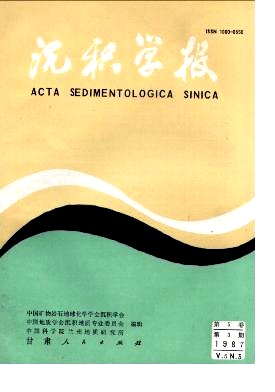FORMATION OF GLAUCONITE AS INFILLINGS OF ORGANISM
- Publish Date: 1987-09-10
Abstract: The mechanism and process of glauconite formation are discussed in this paper. The glauconite grains, sampled from the continental shelf of north part of South China Sea ( 116°08'-116°17'E, 21°20'-21°35'N ) and from the upper slop of East China Sea ( 128°00'E, 30°00'N), have various kinds of morphologies, most of them are as the infillings of foraminiferal shells. Their colour ranges coutinuously from dark, through greenish-black and greenish-yellow, to light yellow. The light colour grains usually contain the remains of organic shells. It can be divided into four stages for glauconite formation according to their colours and morphologies. By using the quantitative analysis of X-ray diffraction, the SEM photomicrographic observation, the chemical analysis and the synthetic experiment, in order to reveal the genesis of the glauconite within the shells of organism. From the analysis of sedimentary environment it is obvious that the biogenetic glauconite grains were formed in the sediments of outer continental shelf and the upper part of continental slop,water depth from 200-400m. The temperature, salinity and pH value favourable for the glauconite formation were the same as those value of normal sea water. The type of sediments in which the glauconite were found was well sorted sand with plenty of organic shells. In this region a steady sediment/sea-water interface was occurred, due to the absence of recent terrigenous sedimentation, which was known as the relict sedimentary region. It should be emphasized, however, that the most important factor for the glauconization was the microenvironment within the organic shells. The microenvironment was established by the decomposition of organisms after they had died and sunk to the sea bottom. The process of glauconization began in the shell where was a slightly reducing condition which was certainly favourable for the migration of active ferrous hydroxide from nearby sediment/sea-water interface into the organic shells. The ferrous hydroxide with Al-Mg hydroxides, and absorbing gelatinous silica, precipitated in the shells and subsequantly crystallized into iron-rich hydrous phyllosilicate. Its internal structure shown by SEM photomicrographs appeared to be an aggregate of random folia with curved edges or/and flake. The crystal structure was disorderly interstratified glauconite with the expansion layer about 63-68% bacause of the shortage of potasium in the structure. It was the initial stage of glauconization that was characterized by the enrichment of iron and lack of potasium in composition and light yellow in colour (NB-4, ZB-4). With the process of aging and gelatination, the authigenic crystallites tended to get arranged as roselike flakes. The break-down of organic shells around the authigenic mineral led to the contact of the grains with sea-water of/and interstitial water. The absorption of potasium reduced the expansible layer to 48-54%. At this stage the grains began to appear green resulting in yellow-green glauconite ( NB-3 and ZB-3). During the growth further the interlayered water was driven out owing to the absorption and fixation of potasium in the structure. As a result, cracks occurred on the surface of the grains. The cracks, in turn, enlarged the extent of metasomatism. The folia got orientedly and closely arranged. The impurities in the grains almost diminished. The grains got greener and dark and the expansion layer decreased to 42-45% at this stage ( NB-2 and ZB-2). Finaly, the authigenic growth of crystallite, the progressive absorption of potasium, the metasomatism of impurities made the structure of the grains more closely and oriented arranged, the surface of the grains more cracked. The crystal structure was changed from mainly expansible to nearly non-expansible ( 25-35%for NB-1 and ZB-1). Such dark glauconite grains are the well evolved grauconite in the modern marine sediments.
| Citation: | Chen Lirong, Duan Weimin. FORMATION OF GLAUCONITE AS INFILLINGS OF ORGANISM[J]. Acta Sedimentologica Sinica, 1987, 5(3): 171-179. |






 DownLoad:
DownLoad: